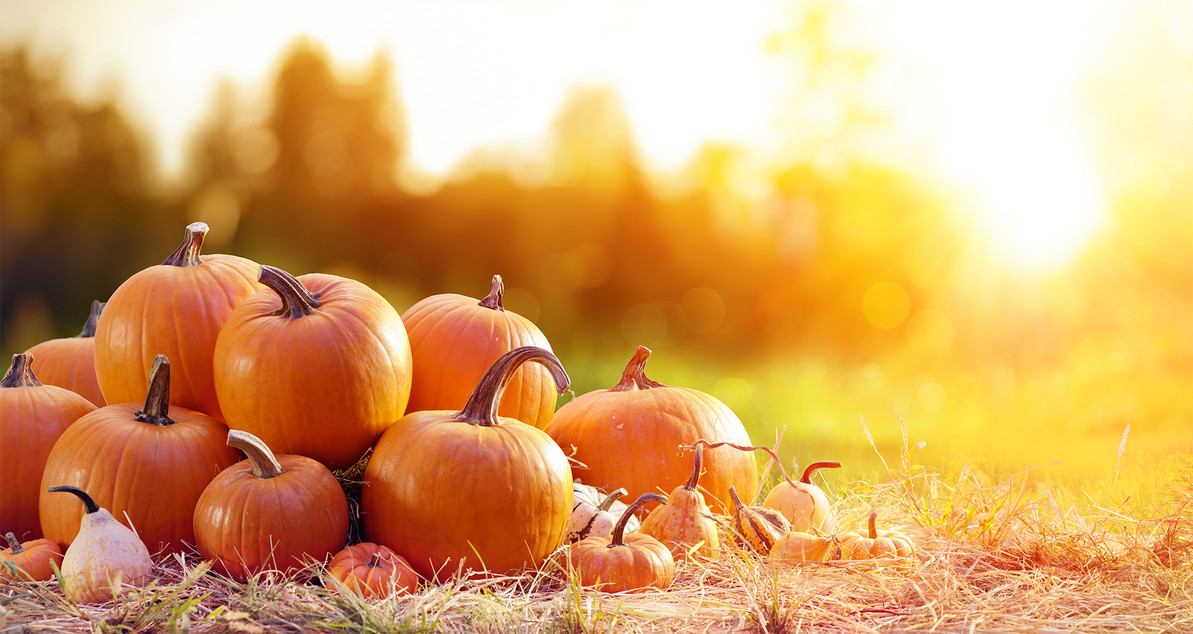Prepare to Celebrate Fall's Most Festive Gourd
Those bright orange globes are almost ready for picking in farmers’ fields. That means only one thing – it’s pumpkin time and for the RVers out there, pumpkins provide an opportunity to have a little fun in the great outdoors or decorate for the season in traditional and non-traditional ways.
People do all sort of things with pumpkins. They carve them, make pumpkin flavored cakes, muffins and pancakes and even hurl these autumn gourds through the air on medieval trebuchets. This gourd which is native to the North American continent is an integral part of American holiday celebrations and heralds the arrival of fall.
Pumpkins have been grown on this continent for five millenniums – that’s 5,000 years. It is a species of winter squash and is characterized by a smooth, ribbed skin with deep yellow to orange in color. The interior of the pumpkin is filled with pulp and seeds, which when roasted make a tasty snack with nutritional value.
The growing seasons starts early because pumpkins take 75 - 100 days to grow. Farmers in the northern climes plant in May for a harvest in September and October. Top pumpkin-producing states are California, Illinois, Indiana, Ohio and Pennsylvania. Pumpkins can be grown on every continent except Antarctica.
Pumpkins weigh on average 6 – 18 pounds, although there are varieties that produce smaller ones and other varieties which produce giant-size ones.
One of the most notable use of pumpkins is in the celebration of Halloween. Jack-o-Lanterns are the new world equivalent of the Irish and English tradition of carving hollowed-out turnips and other vegetables into lanterns, a practice that was believed to ward off evil spirits. In this continent, Jack-o-Lanterns are a Halloween staple, with decorating options including the old-time favorite carving, to more crafty versions using paint, markers, fabric and even glitter.
Because there is no right or wrong to pumpkin carving, it has become an easy and fun activity for families to do together. There are stencils that can be used by the artistically challenged, but pumpkins can take on a variety of personalities – from scary to funny, from Halloween-related to messages of peace and love, and everything in between.
Another way to use pumpkins in décor without going through the trouble and the mess of carving is simply to put this fall harvest product in a window, on a table, outside on the patio, porch or campsite pad. Mixing the pumpkin with other fall gourds is a festive way to incorporate the colors of the season in a way that won’t clash with any decorating scheme.
Another suggestion is to cut the top off the pumpkin, clear out the pulp and seeds and create a pot for fall flowers. As most fall flowers are annuals and won’t last very long, when the plant has lived its lifetime, simply discard.
Although pumpkins are everywhere during the early fall season, it is always fun to head to a pumpkin patch and choose one for yourself. Let your children pick out the ones they want and let them decorate these when you get home.
Just like any you-pick produce, there are some helpful suggestions to make sure you make the right choice. Picking a pumpkin the right way ensures it stays ripe longer.
- Harvest when pumpkins are mature. Pumpkins should not be picked off the vine, unless they have fully matured. If size matters and you want a small pumpkin, look for the varieties that stay on the small size. Cutting a pumpkin off the vine because it is the size you need is not recommended.
- Check for ripeness: A pumpkin is ripening when its skin turns a deep, solid color. Thumping the pumpkin with a finger is also a clue as to the ripeness of the pumpkin. One that is ripe for the picking will have a hard rind and will resist applied fingernail pressure
- Follow proper pumpkin harvesting protocol. Cut it off the vine with a knife; don’t simply tear it off. Allow 3 - 4 inch stem to slow decay. Remember to handle gently because the skin will bruise.
- Cure the pumpkin in the sun for about a week to toughen the rind. Store the pumpkin in a cool, dry place. Best temperature for pumpkin storage is 55ºF.
The adage waste not, want not applies conveniently to pumpkins. After carving a jack-o-lantern, the pulp and the seeds can also be used. Actually, almost every part of the pumpkin has culinary and nutritional value, even the leaves and flowers.
Pumpkins can be boiled, steamed, or roasted. Mashed, pumpkin pulp is used in soups, purees and the filling in pumpkin pies.
Nutritionally, raw pumpkin is a good source of energy and provides provitamin A beta-carotene and vitamin A. Pumpkins are 92% water, 6.5% carbohydrate, 0.1% fat and 1% protein. The seeds are a good source of protein, magnesium, copper and zinc. Raw pumpkin is also beneficial to pets with digestive issues.
While apple pie remains a truly American dessert, pumpkin is running a close second. Pumpkin pie is served at holiday meals and the prevalence of pumpkin spice lattes, coffees, donuts and other seasonal treats has helped establish this festive gourd as a sign of the season.
This fall let out the artist inside and carve, paint or sculpt a fall creation. Roast those pumpkin seeds to enjoy as a treat while driving down the road. Or find a recipe that stretches the culinary muscles by adding pumpkin to a dish. Celebrate the pumpkin and herald fall.
Recent Posts
-
How To Keep RV Furniture From Peeling
Peeling RV Furniture | Why it Peels and How to Stop it Your RV furniture is a point of pride on …Apr 23rd 2024 -
4 Tips for Securing RV Furniture While Traveling | RecPro
How To Secure RV Furniture There are few things that beat going out on an adventure with an RV …Apr 11th 2024 -
Can You Put Regular Furniture in an RV?
Can you put regular furniture in an RV? Many new and old RV owners ask themselves this qu …Apr 8th 2024 -
Are RV Electric Fireplaces Safe
Being Safe in Your RV with an Electric Fireplace Safety is always going to be one of your highest …Apr 4th 2024 -
How To Install An RV Fireplace
A Warm Addition to Your On-Wheels: The DIY RV Fireplace Installation Guide Many RV enthusiasts ask …Apr 1st 2024 -
Essential Grilling Gear Every RVer Needs
Whether or not you consider yourself a pitmaster or grillmaster, if you’re out on the road with y …Mar 18th 2024







